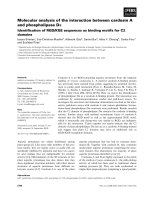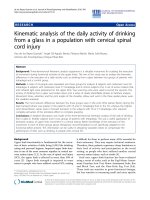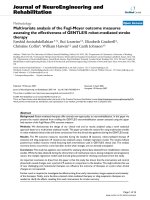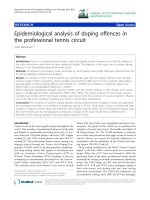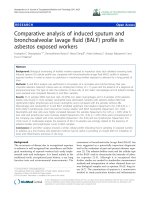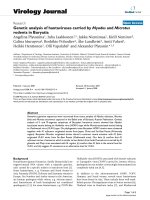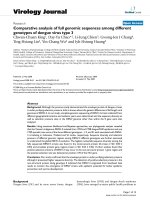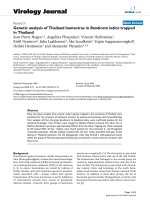Báo cáo hóa học: " Throughput Analysis of Fading Sensor Networks with Regular and Random Topologies" docx
Bạn đang xem bản rút gọn của tài liệu. Xem và tải ngay bản đầy đủ của tài liệu tại đây (839.21 KB, 11 trang )
EURASIP Journal on Wireless Communications and Networking 2005:4, 554–564
c
2005 X. Liu and M. Haenggi
Throughput Analysis of Fading Sensor Networks
with Regular and R andom Topologies
Xiaowen Liu
Department of Electrical Engineering, University of Notre Dame, Notre Dame, IN 46556, USA
Email:
Martin Haenggi
Department of Electrical Engineering, University of Notre Dame, Notre Dame, IN 46556, USA
Email:
Received 30 November 2004; Revised 5 June 2005
We present closed-form expressions of the average link throughput for sensor networks with a slotted ALOHA MAC protocol in
Rayleigh fading channels. We compare networks with three regular topologies in terms of throughput, transmit efficiency, and
transport capacity. In particular, for square lattice networks, we present a sensitivity analysis of the maximum throughput and
the optimum transmit probability with respect to the signal-to-interference r atio threshold. For random networks w i th nodes
distributed according to a two-dimensional Poisson point process, the average throughput is analytically characterized and nu-
merically evaluated. It turns out that although regular networks have an only slightly higher average link throughput than random
networks for the same link distance, regular topologies have a significant benefit when the end-to-end throughput in multihop
connections is considered.
Keywords and phrases: throughput, Rayleigh fading, slotted ALOHA, network topology, interference.
1. INTRODUCTION
A sensor network [1] consists of a large number of sensor
nodes which are placed inside or near a phenomenon. Uni-
formly random or Poisson distributions are widely accepted
models for the location of the nodes in wireless sensor net-
works, if nodes are deployed in large quantities and there is
little control over where they are dropped. A typical scenario
is a deployment from an airplane for battlefield monitoring.
On the other hand, depending on the application, it may also
be possible to place sensors in a regular topology, for exam-
ple, in a square grid.
Throughput is a traditional measure of how much traf-
fic can be delivered by the network [2, 3]. There is a rich
literature on throughput capacity for wireless networks [2,
4, 5] with random or regular topologies. The seminal pa-
per [2] shows that, for peer-to-peer traffic, in a static two-
dimensional network with N nodes and N/2randomlyse-
lected source-destination pairs, the end-to-end throughput
of a connection is Θ(W/
√
N), where W is the maximum
transmission rate for each node. The reason for this poor
This is an open access article distributed under the Creative Commons
Attribution License, which permits unrestricted use, distribution, and
reproduction in any medium, provided the original work is properly cited.
scaling behavior is that the per-link
1
throughput remains
constant while the number of hops grows with
√
N.Marco
et al. [6] show that with many-to-one traffic, the per-node
transport capacity is Θ(1/N). Such “order of” results do not
provide any guidelines for protocol design, since the scaling
behavior is very robust against changes in MAC and routing
protocols [7]. All the above research work assumes networks
with randomly located nodes. There are also research efforts
focusing on networks with regular topologies. Silvester and
Kleinrock [4] calculate the throughput of regular square net-
works with a slotted ALOHA channel access scheme. Xie and
Kumar [7] prove that the Θ(N)upperboundontransport
capacity is tight for regular networks where nodes are placed
on integer lattice points for path loss exponents g reater than
3 and is achieved by multihop transmission. De et al. [8]
compare the performance of regular topologies with random
topology in wireless CDMA sensor networks. The authors in
[9, 10] evaluate the performance for regular grid and random
topologies. They assume a “torus” network to avoid bound-
ary effects and use the expected interference power to re-
place the exact interference power. In par ticular at high load,
1
The link throughput is the total achievable throughput over a link, ag-
gregated over the flows or connections that are served by the link.
Throughput Analysis of Random and Regular Networks 555
replacing the actual interference by its mean yields overly
pessimistic results. Indeed, the expected interference may be
infinite [11].
Most of the work above is based on a “disk model,” where
it is assumed that the radius for a successful transmission of a
packet has a fixed and deterministic value, irrespective of the
condition and the realization of the wireless channel. Such
simplified link models ignore the stochastic nature of the
wireless channel. Our analysis is based on a Rayleigh fading
channel model, which includes both large-scale path loss and
stochastic small-scale variations in the channel characteris-
tics. Note that even with static nodes as assumed in this pa-
per, the channel quality varies because any movement in the
environment affects the multipath geometry of the RF sig-
nal, which is easily confirmed experimentally [12, page 45].
The significant variation of the link quality when nodes are
immobile is also pointed out in [13, 14, 15], and the short-
comings of the “disk model” are discussed in [11].
This paper addresses the throughput problem for large
sensor networks with Rayleigh fading channels. To provide
insight on the impact of the topolog y on the network per-
formance, we compare networks with a random topology
and three regular topologies. Placing nodes in regular lat-
tices has an obvious advantage in terms of coverage [16],
so we are not addressing coverage issues here. We define the
(per-link) throughput as the expected number of successful
packet transmissions of a given link per timeslot. The end-to-
end throughput over a multihop connection, defined as the
minimum of the throughput values of the links involved, is a
performance measure of a route and the MAC scheme.
We consider a variant of the slotted ALOHA channel ac-
cess scheme, originally devised in [17], that takes advantage
of spatial reuse. It is assumed, as in [4, 18, 19, 20], that in ev-
ery timeslot, each node transmits independently with a cer-
tain fixed probability p. While often a “heavy traffic” model
is used [4, 20], where nodes always have packets to trans-
mit and p only reflects the channel access probability, we do
not restrict ourselves to this “MAC-centric” case. Rather, we
consider p to be composed of two factors, that is, p
= p
q
p
t
,
where p
q
is the probability that there is a packet in a node’s
queue awaiting transmission, and p
t
is the probability of
transmission conditioned on having a packet in the queue
(the channel access probability). So, p
q
is given by the traffic
model, p
t
is the actual slotted ALOHA channel access prob-
ability, and p is the unconditioned probability of transmis-
sion. The heavy traffic case mentioned above corresponds to
p
q
= 1, p
t
= p, and the other extreme case is p
q
= p, p
t
= 1,
where Bernoulli traffic is generated with probability p
q
and
each node with a packet to transmit has immediate access
to the channel. Since there is no need for a MAC scheme in
this case, we may denote it as “traffic-centric.” Hence, the de-
composition of p shows that the throughput analysis and op-
timization with respect to p in fact includes a range of traf-
fic intensities and channel access probabilities. The Bernoulli
traffic model is well justified by the following three observa-
tions: (1) in [18], it was shown that the traffic from a slot-
ted ALOHA population of nodes can indeed be modeled as
Bernoulli; (2) in [21, page 278], it is pointed out that the
retransmission traffic is usually Bernoulli (since an unsuc-
cessfully transmitted packet reenters the queue); and (3) the
Bernoulli traffic model is memoryless and thus the discrete-
time counterpart of the ubiquitous Poisson model.
The traffic distribution in a sensor networks is usually
spatially and temporally bursty, that is, busy periods alter-
nate temporally and busy areas alternate spatially with pe-
riods and areas with little or no traffic. It may therefore be
impractical to employ reservation-based MAC schemes such
as TDMA and FDMA that require a substantial amount of
coordination traffic and cannot be implemented efficiently
and in a fully distributed fashion.
2
In any case, the slotted
ALOHA scheme is the simplest meaningful MAC scheme and
therefore provides a lower bound on the performance for
more elaborate schemes. Since areas of the network or pe-
riods with little or no traffic pose no problems, our analysis
focuses on a nd applies to busy areas and busy periods of the
network where collisions are unavoidable and the through-
put is interference-limited. During such a burst of traffic, we
assume that the parameters p, p
q
,andp
t
remain constant.
An important example of a busy area is certainly the critical
area around the base station or fusion center, where traffic
accumulation due to the many-to-one transmission scheme
often results in heavy traffic[22].
In Section 2, the Rayleigh fading link model is intro-
duced. For a slotted ALOHA MAC scheme, the conditional
success probability of a transmission for a node given the
transmitter-receiver and interference-receiver distances is de-
rived. Section 3 ev aluates the throughput for regular net-
works with three topologies and compares their perfor-
mance. Section 4 investigates the average throughput for ran-
dom networks for fixed and random transmitter-receiver dis-
tances d
0
. This section also analyzes the transport capacity
and end-to-end throughput. Section 5 concludes the paper.
2. THE RAYLEIGH FADING LINK MODEL
We assume a narrowband Rayleigh block fading channel.
A transmission from node i to node j is successful if the
signal-to-noise-and-interference ratio (SINR) γ
ij
is above a
certain threshold Θ that is determined by the communica-
tion hardware and the modulation and coding scheme [14].
The SINR γ is given by γ = Q/(N
0
+ I), where Q is the re-
ceived power, which is exponentially distributed with mean
¯
Q. Over a transmission of distance d with an attenuation d
α
,
we have
¯
Q = P
0
d
−α
,whereP
0
denotes the transmit power, α
is the path loss exponent. N
0
denotes the noise power, and I is
the interference power, that is, the sum of the received power
from all the undesired transmitters. Our analysis is based on
the following theorem.
Theorem 1. In a Rayleigh fading network with slotted
ALOHA, where nodes transmit at equal power levels with prob-
ability p,thesuccessprobabilityofatransmissiongivenade-
sired transmitter-receiver distance d
0
and n other nodes at
2
In general, this problem is NP-hard.
556 EURASIP Journal on Wireless Communications and Networking
distances d
i
(i = 1, , n)is
P
s|d
0
, ,d
n
= exp
−
ΘN
0
P
0
d
−α
0
·
n
i=1
1 −
Θp
d
i
/d
0
α
+ Θ
,(1)
where P
0
is the transmit power, N
0
the noise power, and Θ the
SINR threshold.
Proof. Let Q
0
denote the received power from the desired
transmitter and Q
i
, i = 1, , n, the received power from n
potential interferers. All the received powers are exponen-
tially distr ibuted, that is, p
Q
i
(q
i
) = 1/
¯
Q
i
e·
−q
i
/
¯
Q
i
,where
¯
Q
i
de-
notes the average received power
¯
Q
i
= P
i
d
−α
i
. The cumulated
interference power at the receiver is
I =
n
i=1
S
i
Q
i
,(2)
where S
i
is a sequence of i.i.d. Bernoulli random variables
with P(S
i
= 1) = p and P(S
i
= 0) = 1 − p. T he success
probability of a transmission is
3
P
s|d
0
,d
1
, ,d
n
= E
I
P
Q
0
Θ(I + N
0
) | I
= E
Q,S
exp
−
Θ
n
i=1
S
i
Q
i
+ N
0
¯
Q
0
= exp
−
ΘN
0
¯
Q
0
E
Q,S
n
i=1
exp
−
Θ
S
i
Q
i
¯
Q
0
= exp
−
ΘN
0
P
0
d
−α
0
×
n
i=1
P
S
i
= 1
·
∞
0
exp
−
Θq
i
¯
Q
0
× p
Q
i
q
i
dq
i
+ P
S
i
= 0
=
exp
−
ΘN
0
P
0
d
−α
0
n
i=1
p
1+Θ
d
0
/d
i
α
+1− p
=
exp
−
ΘN
0
P
0
d
−α
0
n
i=1
1 −
Θp
d
i
/d
0
α
+ Θ
.
(3)
Since the throughput in large sensor networks is limited
by the interference, in the following, we focus on the inter-
ference part (the second factor of (3), assuming N
0
= 0)
to determine bounds that are fundamental in the sense that
they cannot be exceeded even if the transmit power is not
constrained. The first exponential term is easily evaluated if
N
0
= 0.
3
A similar calculation has been carried out in [23]forthecasewherein
every timeslot it is known exactly which node is transmitting. In contrast,
Theorem 1 incorporates the uncertainty at the MAC level: we only assume
we know the probability of a transmission, but not exactly which node is
transmitting in every timeslot.
Corollary 1. Under the same assumptions as in Theorem 1 but
w ith N
0
= 0 and unit transmit power P
i
= 1,thesuccessprob-
ability given a desired link of normalized distance r
0
= d
0
/d
0
=
1 and n other nodes at normalized distances r
i
= d
i
/d
0
is
P
s|r
0
,r
1
, ,r
n
=
n
i=1
1 −
p
1+r
i
α
/Θ
= L
I
(Θ), (4)
which is the Laplace transform of the inter ference power I eval-
uated at the SIR threshold Θ.
Proof. With unit tr ansmit power, the mean power from the
ith interferer at distance r
i
is 1/r
α
i
. The Laplace transform of
the exponential distribution with mean 1/µ is µ/(µ + s), thus
the Laplace t ransform of I is [24]
L
I
(s) =
n
i=1
pr
α
i
r
α
i
+ s
+1− p
=
n
i=1
1 −
p
1+r
α
i
/s
. (5)
From (3)andwithr
i
= d
i
/d
0
(normalized distances), if N
0
=
0,
P
s|r
0
,r
1
, ,r
n
=
n
i=1
1 −
p
1+r
i
α
/Θ
,(6)
we get (4).
3. REGULAR NETWORKS
In this section, we investigate networks with three regular
topologies (square, triangle, hexagon) in which every node
has the same number of nearest neighbors and the same dis-
tance to all nearest neighbors.
3.1. Square networks
We first analyze square networks with N nodes placed in the
vertices of a square grid with distance 1 between all pairs
of nearest nodes (density 1). T he next-hop receiver of each
packet is one of the four nearest-neighbor nodes of the trans-
mitter, so the transmitter-receiver distance d
0
= 1. If the re-
ceiver node O is located in the center of the network as shown
in Figure 1 and node A is the desired transmitter, the success
probability for node O based on (6)canbewrittenas
P
s
(p) =
1 −
Θp
1
α
+ Θ
3
·
1 −
Θp
√
2
α
+ Θ
4
×
√
N/2
i=2
1 −
Θp
i
α
+ Θ
4
·
1 −
Θp
√
2i
2
α
+ Θ
4
·
i−1
j=1
1 −
Θp
i
2
+ j
2
α
+ Θ
8
.
(7)
Throughput Analysis of Random and Regular Networks 557
O
A
Figure 1:Thetopologyofasquarenetwork.NodeO is the receiver
and node A is the desired transmitter such that the link distance
d
0
=|OA|=1.
0
0.01
0.02
0.03
0.04
g
α = 5
α = 2
00.20.40.60.81
p
Figure 2: The analytic throughput g(p)basedon(7)forasquare
network with 40 ×40 nodes, with Θ = 10.
Thefirsttermin(7) accounts for the other three nearest-
neighbor nodes of the receiver; the second term for the 4
diagonal nodes at distance
√
2; all the other terms from
the nodes located on the dashed squares with edge ≥ 2in
Figure 1. The throughput
4
is given by
g(p) = p(1 − p)P
s
(p), (8)
where p is the probability that A transmits and 1 − p is the
probability that O does not transmit in the same timeslot.
Note that g is the throughput achievable with a simple
ARQ scheme (with error-free feedback) [25]. The analytic
throughput g(p)basedon(7)and(8) for a regular square
4
The throughput is calculated as the throughput of the center link of
the busy area under consideration. This is the worst case since most other
nodes experience a lower interference. In the case of infinite networks, the
interference distribution is the same at every node.
network with 40 × 40 nodes with node density λ = 1 is dis-
played in Figure 2.Forα = 4, the maximum throughput
g
max
= 0.0247 is achieved at an optimal transmit probabil-
ity p
opt
= 0.066. The transmit efficiency, defined as T
eff
=
g
max
/p
opt
,is37.4%.
For the sensitivity analysis of the throughput with respect
to Θ, we need to determine p
opt
(Θ)andg
max
(Θ). We use
three analytic approximations for p
opt
(Θ)andg
max
(Θ). From
(6), g can be written as
g = p(1 − p)
n
i=1
1 −
p
1+r
α
i
/Θ
,(9)
where r
i
= d
i
/d
0
.
Since p
opt
= arg max
p
g(p) = arg max
p
log(g(p)), we
maximize
log(g) = log(p) + log(1 − p)
+
n
i=1
log
1 −
p
1+r
α
i
/Θ
,
(10)
using log(1 + x) ≈ x for small x,
5
yielding
p
2
opt
− p
opt
(1 + 2s)+s = 0, (11)
with
s =
1
n
i=1
(1/(1 + r
α
i
/Θ))
. (12)
Note r
i
= d
i
for d
0
= 1. So, p
opt
is given by
p
opt
= s +
1
2
1 −
1+4s
2
. (13)
g
max
can be obtained by g
max
= p
opt
(1 − p
opt
)P
s
(p
opt
), where
P
s
(p
opt
) is obtained by plugging p
opt
into (7). This method is
called Analytic 1.
For α = 4, we use i
2
to approximate d
4
i
for the nodes
located in one quadrant. As shown in Figure 3, the distance
of node i (i = 1, , 8) in the first quadrant to the receiver
node O is d
i
. Ta ble 1 compares d
4
i
and i
2
for i = 1, ,8.By
Euler’s summation formula, d
4
i
≈ i
2
allows a simplification
(the node at distance 1 is the desired transmitter):
k+1
i=2
1
1+i
2
/Θ
≈
Θ
arctan
k +3/2
√
Θ
− arctan
3
2
√
Θ
. (14)
For k →∞,
s
≈
1
4
√
Θ
π/2 −arctan(3/2
√
Θ)
, (15)
5
The approximation is accurate for p in the range of interest, that is,
0 <p<0.3.
558 EURASIP Journal on Wireless Communications and Networking
O
15
3
4
2
6
7
8
Figure 3: Node numbering scheme pertaining to Table 1 for nodes
in the first quadrant of a square network. O is the receiver.
Table 1: Comparison of d
4
i
and i
2
.
i 12345678
d
4
i
1141616252564
i
2
1491625364964
wherethefactor4in(15) comes from the fact that nodes are
located in 4 quadrants. Plugging (15) into (13) is our method
Analytic 2.
In method Analytic 3, we use the approximation s ≈
1/(4
√
Θ), which is within ∓20% for the practical range
9/(2 cot(0.8))
2
≈ 2.4 < Θ < 9/(2 cot(1.2))
2
≈ 14.9, and sub-
stitute it into (13), which yields
p
opt
=
1
4
√
Θ
+
1
2
1 −
1+
1
4Θ
. (16)
Based on (10)and(12), g
max
is given by
g
max
= p
opt
1 − p
opt
e
−p
opt
/s
. (17)
The numerical result obtained by direct maximization of (7)
for different Θ is compared with the results from the three
analytical approximations in Figure 4.InAnalytic 2, approx-
imating interfering nodes at distance d
i
by the larger distance
i
1/2
(shown in Table 1) results in lower interference. The in-
terference has a more significant impact on the throughput
(and p
opt
) for small Θ (see (14)). Thus for small Θ, this lower
interference leads to a higher p
opt
than for Analytic 1.The
transmit efficiency is T
eff
= g
max
/p
opt
= (1 − p
opt
)e
−p
opt
/s
,
which is monotonically increasing from lim
s→0
T
eff
= e
−1
≈
0.37 to lim
s→∞
T
eff
= 1/2.Theupperboundisachievedif
the interference goes to zero, in which case p
opt
= 1/2and
g
max
= 1/4. For the lower bound, as s → 0, we have p
opt
→ 0
and g
max
→ 0, and T
eff
converges to e
−1
.Hence,s is a measure
for spatial reuse. Indeed for s → 0, which happens for α → 0
6
or Θ →∞, the network does not permit any spatial reuse. In
6
In fact, α → 2issufficient for infinite networks.
0
0.05
0.1
0.15
0.2
0.25
p
opt
0 5 10 15 20
Θ (dB)
Numerical
Analytic 1
Analytic 2
Analytic 3
(a)
0
0.02
0.04
0.06
0.08
0.1
g
max
0 5 10 15 20
Θ (dB)
Numerical
Analytic 1
Analytic 2
Analytic 3
(b)
Figure 4: For a square network with 40 × 40 nodes and α = 4, the
numerical results and analytic results from Analytic 1, Analytic 2,
and Analytic 3 for (a) the relationship between p
opt
and Θ;(b)the
relationship between g
max
and Θ.
this case, the transmit efficiency reduces to the efficiency of
conventional slotted ALOHA [17], where for a network with
N nodes, p
opt
= 1/N and T
eff
= lim
N→∞
(1 − 1/N)
N−1
= e
−1
[4]. The fact that our limit coincides with the limit for con-
ventional slotted ALOHA further validates our approxima-
tions.
3.2. Triangle networks and hexagon networks
Other regular topologies of interest are the triangle topol-
ogy and its dual, the hexagon topology (Figure 5). For each
triangle, there are three vertices and six nearest neighbors
for each vertex, while for the hexagon, there are six ver-
tices for each hexagon and three nearest neighbors for each
vertex. Again, the next-hop receiver of each packet is one
Throughput Analysis of Random and Regular Networks 559
(a) (b)
Figure 5: The topology of (a) triangle network and (b) hexagon network.
0
0.01
0.02
0.03
0.04
0.05
0.06
g
00.20.40.60.81
p
α = 2
α = 5
(a)
0
0.01
0.02
0.03
0.04
0.05
0.06
g
00.20.40.60.81
α = 2
α = 5
p
(b)
Figure 6: The analytic throughput g(p)versusp for two-dimensional networks with (a) triangle topology and (b) hexagon topology, where
Θ = 10 and N = 1600 nodes.
of the nearest-neighbor nodes of the transmitter, so the
transmitter-receiver distance d
0
is equal to the side length
of the regular polygon. In the triangle network, each node
is located in a hexagon with area (
√
3d
2
0
)/2. For node den-
sity equal to 1, d
2
0
= 2/
√
3. Similarly, for hexagon networks,
d
2
0
= 4/(3
√
3).
Similar to the calculation of square lattice networks as
in (7), we obtain the relationship between the throughput
g and the transmit probability p and compare the perfor-
mance of triangle and hexagon networks in Figure 6.Fora
fair comparison, we introduce the transport capacity which
can be defined as Z := g
max
d
0
. The results for square,
triangle, and hexagon networks for α = 4 are shown in
Tabl e 2 . The performance difference among the three topolo-
gies can be explained by the distance and number of the
potential interfering nodes. Note that the transmit efficiency
T
eff
is very close to the one of conventional slotted ALOHA
and does not depend on the topology.
4. RANDOM NETWORKS
Here, we assume that the positions of the nodes constitute a
Poisson point process.
7
In the following, we will investigate
the throughput averaged over network realizations when the
transmitter-receiver distance d
0
is fixed (Section 4.1 ) and not
fixed (Section 4.2).
4.1. Average throughput for fixed d
0
In this case, we assume the distance between the desired
transmitter and receiver is fixed and there are N other nodes
constituting a two-dimensional Poisson point process. Al-
though (6) gives the success probability conditioned on
node distances, we still need to find the joint density of
7
For large networks, this is equivalent to a uniformly random distribu-
tion for all practical purposes.
560 EURASIP Journal on Wireless Communications and Networking
Table 2: Comparison of square, triangle, and hexagon networks
for α = 4andΘ = 10, where p
opt
, g
max
,andT
eff
denote the op-
timum transmit probability, maximum throughput, and transmit
efficiency.
p
opt
g
max
T
eff
d
0
g
max
d
0
Square 0.0660 0.0247 0.37 1.00.0247
Triangle 0.0570 0.0213 0.37 1.0746 0.0229
Hexagon 0.0870 0.0326 0.37 0.8774 0.0286
d
1
, d
2
, , d
N
(ordered distances). It is well known that for
one-dimensional Poisson point processes with density λ, the
ordered distance from nodes to the desired receiver form the
arrival times of a Poisson process [24]. The interarrival inter-
vals are i.i.d. exponential with parameter λ:
f
d
i
−d
i−1
x
i
− x
i−1
=
λe
−λ(x
i
−x
i−1
)
. (18)
So, for the ordered distance 0 ≤ d
1
≤ ··· ≤ d
N
, the joint
density function of the interarrival intervals is
f
d
1
,d
2
, ,d
N
x
1
, x
2
, , x
N
= f
d
1
, ,d
N
−d
N−1
x
1
, x
2
− x
1
, , x
N
− x
N−1
=
λe
−λx
1
λe
−λ(x
2
−x
1
)
···
λe
−λ(x
N
−x
N−1
)
=
λ
N
e
−λx
N
,0≤ x
1
≤ x
2
≤···≤x
N
.
(19)
When nodes are distributed according to a two-dimensional
Poisson point process with density λ, the squared ordered
distances from the desired receiver have the same distribu-
tion as the arrival times of a Poisson process with density λπ
[24]. The squared ordered distances have a joint distribution
with density
f
d
2
1
, ,d
2
N
x
1
, , x
N
= (λπ)
N
e
−λπx
N
,
0 ≤ x
1
≤ x
2
≤···≤x
N
,
(20)
because from [26], we have
f
d
2
i
−d
2
i−1
x
i
− x
i−1
= λπe
−λπ(x
i
−x
i−1
)
. (21)
The conditional success probability can be written as (see
(6))
P
s|d
0
,d
1
, ,d
N
=
N
i=1
(d
2
i
)
α/2
+(1− p)Θd
α
0
(d
2
i
)
α/2
+ Θd
α
0
. (22)
Integrating (22) with respect to the joint density (20), and in
particular, evaluating it for α = 4, we obtain
P
s|d
0
=
∞
0
(λπ)
N
e
−λπx
N
×
x
N
0
···
x
2
0
N
i=1
x
2
i
+(1−p)Θd
4
0
x
2
i
+ Θd
4
0
dx
1
···dx
N−1
dx
N
.
(23)
0
0.005
0.01
0.015
0.02
0.025
E[g|d
0
]
00.20.40.60.81
p
N = 100
N = 121
N = 144
Figure 7: For α = 4andΘ = 10, the analytical average throughput
E[g|d
0
= 1]basedon(25) for networks with node number N =
100, 121, and 144.
By applying a similar inductive technique as in [24], it can be
shown that
x
N
0
···
x
2
0
N−1
i=1
x
2
i
+(1− p)Θd
4
0
x
2
i
+ Θd
4
0
dx
1
···dx
N−1
=
1
(N − 1)!
x
N
− p
Θd
4
0
arctan
x
N
Θd
4
0
N−1
.
(24)
Combining (23)and(24), we have
P
s|d
0
=
∞
0
(λπ)
N
(N − 1)!
e
−λπx
x
2
+(1− p)Θd
4
0
x
2
+ Θd
4
0
×
x − p
Θd
4
0
arctan
x
Θd
4
0
N−1
dx.
(25)
Based on (25), we numerically evaluate the average through-
put E[g|d
0
] = p(1 − p)P
s|d
0
(averaged over all network re-
alizations) a nd plot it as a function of p in Figure 7 for a
network with node numbers N = 100, 121, and 144, where
d
0
= 1. It is shown that they are very close, indicating that
only a portion of the nodes interfere at the receiver and nodes
further away have l ittle impact on the transmission.
4.2. Average throughput for variable d
0
In the previous analysis, we assumed that the transmitter-
receiver distance d
0
is fixed and there are N potential interfer-
ing nodes uniformly distributed. Now we assume that the re-
ceiver located at the center selects its nearest-neighbor node
as its desired transmitter. Then there are N −1 nodes further
away than the desired transmitter. The distance to the near-
est neighbor has the Rayleigh density function (as shown in
[23])
f
d
0
(x) = 2πxe
−πx
2
. (26)
Throughput Analysis of Random and Regular Networks 561
0
0.02
0.04
0.06
0.08
0.1
E[g]
00.20.40.60.81
p
Analytic
Simulation
Figure 8: For α = 4andΘ = 10, E[g]versusp for random network
with N = 144. The analytic result from (27) and (30) is displayed
by solid line; the simulation result over 10 000 runs by + mark.
Since d
0
is the nearest distance, d
2
i
in (22) can be varying
from d
2
0
to d
2
i+1
. So we integrate x
i
from d
2
0
to x
i+1
:
P
s|d
0
=
∞
d
2
0
f
d
2
1
, ,d
2
N−1
|d
2
0
x
1
, , x
N−1
|d
2
0
×
x
N−1
d
2
0
···
x
2
d
2
0
N−1
i=1
x
2
i
+(1−p)Θd
4
0
x
2
i
+ Θd
4
0
dx
1
···dx
N−2
dx
N−1
,
(27)
f
d
2
1
, ,d
2
N−1
|d
2
0
x
1
, , x
N−1
|d
2
0
= (λπ)
N−1
e
−λπ(x
N−1
−d
2
0
)
, (28)
where 0 ≤ d
2
0
≤ x
1
≤···≤x
N−1
.
By induction, it can be shown that
x
N−1
d
2
0
···
x
2
d
2
0
N−2
i=1
x
2
i
+(1− p)Θd
4
0
x
2
i
+ Θd
4
0
dx
1
···dx
N−2
=
1
(N − 2)!
x
N−1
− d
2
0
− p
Θd
4
0
·
arctan
x
N−1
Θd
4
0
− arctan
d
2
0
Θd
4
0
N−2
.
(29)
The success probability is P
s|d
0
averaged over d
0
:
P
s
=
∞
0
f
d
0
(x)P
s|d
0
dx. (30)
Substitute (28)and(29) into (27)andevaluate(30)with
(26), we obtain the relationship between E[g] = p(1 − p)P
s
and p, which is plotted in Figure 8. It is shown that the ana-
lytic ( solid line) and simulation result (marked by +) match
perfectly.
0
0.05
0.1
E[g|d
0
]
0.5
1
1.5
d
0
0
0.2
0.4
0.6
0.8
1
p
(a)
0
0.05
0.1
0.15
0.2
0.25
E[g|d
0
]
00.20.40.60.81
p
d
0
= 0.1
d
0
= 0.5
d
0
= 1
d
0
= 1.5
(b)
Figure 9: For α = 4andΘ = 10, average throughput (a) E[g|d
0
]
versus p for d
0
from 0.5to1.5; (b) E[g|d
0
]versusp for d
0
= 0.1,
0.5, 1.0, and 1.5.
Figure 8 implies random networks have better average
throughput for local data exchange than regular networks.
This can be explained by d
0
, the transmitter-receiver dis-
tance. In random networks, a variable d
0
leads to a vari-
able throughput. Figure 9a displays E[g|d
0
]versusp for d
0
from 0.5to1.5. Figure 9b shows the relationship for d
0
=
0.1, 0.5, 1.0, and 1.5. Not surprisingly, smaller d
0
results in
higher throughput. For the variable d
0
case, it is assumed that
the desired transmitter is the nearest neighbor of the receiver.
With the pdf of (26), the probability that d
0
is greater than
1 (the transmitter-receiver distance in the square lattice net-
work) is P[d
0
> 1] = e
−π
= 0.043. So for most nodes, the
received signal power from the desired transmitter is greater
than that in regular networks. In Figure 9b,ford
0
= 0.1, it is
shown that the strong signal power resulting from very small
d
0
offsets the impact of interference even for high transmit
probabilities p.
562 EURASIP Journal on Wireless Communications and Networking
0
0.005
0.01
0.015
0.02
0.025
E[g|d
0
]
0
0.20.40.60.81
p
Regular
Random
Figure 10: Comparison of the average throughput of regular square
network and random network. For both networks, N = 1600, d
0
=
1, α = 4, and Θ = 10.
Now consider the generic routing strategy from [23]:
each node in the path sends packets to its nearest neigh-
bor that lies within a sector φ, that is, within ±φ/2 of the
source-destination direction. The previous scheme where d
0
is obtained as the distance to the nearest neighbor makes no
progress in the source-destination direction. Such a choice
of d
0
would correspond to routing within φ = 2π, clearly an
inefficient choice of φ. More sensible is φ ≤ π.Letd
0
be the
distance to the nearest neighbor within sector φ.Theproba-
bility density of d
0
is given by [23]
f
d
0
(x) = xφe
−x
2
φ/2
. (31)
If the routing sector φ = π/2, then E[d
0
] = 1. For d
0
= 1,
Figure 10 displays the throughput for square network and
random network with N = 1600. It turns out that for the
same transmitter-receiver distance, square networks have a
slightly higher average throughput than random networks.
We compare the transport capacity g
max
d
0
of regular and
random networks. Figure 11a shows g
max
versus d
0
and p
opt
versus d
0
for a random network. Figure 11b compares the
transport capacity of random and regular networks. It is
shown that at a specific tr ansmitter-receiver distance d
0
,reg-
ular networks slightly outperform random networks in terms
of transport capacity.
4.3. End-to-end throughput g
EE
in a random network
In wireless sensor networks with multihop communication,
the end-to-end throughput (the minimum of the throughput
values of the links involved) of a route with an average num-
ber of hops is a better performance indicator than the average
throughput. For two-dimensional random sensor networks
(busy area m × m, density 1, routing within sector φ)with
uniformly randomly selected source and fixed destination
located at the corner,
8
we can approximate the average path
length in hops
¯
h
≈
¯
r
¯
Dη
, (32)
where
¯
r denotes the expected distance between the source
and the destination,
¯
D the expected hop length, and η the
expected path efficiency, where the path efficiency is the ratio
between the Euclidean distance and the travelled distance of
a path.
¯
Dη can be viewed as the effective hop length—the av-
erage hop length projected onto the source-destination axis.
The expected distance from a random point in a square to a
corner can be derived from [27, Exercise 2.4.5]:
¯
r =
√
2
3
+
1
3
arctanh
1
√
2
m ≈ 0.769m. (33)
From [23], we know that
¯
D =
π
2φ
, η =
2
φ
sin
φ
2
. (34)
So the average path length in hops can be approximated by
plugging (33) into (32). To evaluate the end-to-end through-
put of a route with
¯
h hops, we use a semianalytic approach
by generating an
¯
h-hop path with each hop length obtained
as a realization of D according to the pdf in (31), and evalu-
ate the throughput of each hop based on Figure 9a. The av-
erage end-to-end throughput is then obtained by taking the
minimum of each path and averaging the minimum over the
number of realizations of the simulated routes. It is shown
in Figure 12 that the maximum end-to-end throughput g
EE
is 0.0086, 0.0053, and 0.0039 for φ = π, π/2, and π/3.
What is the end-to-end throughput for regular networks?
It can be directly obtained from Figures 2 and 6,whichis
0.0247, 0.0213, and 0.0326 for square, triangle, and hexa-
gon networks. For regular networks, every hop h as the same
length, and the throughput is c alculated for a link in the cen-
ter of the network, which is the worst case, so the end-to-end
throughput is the throughput of the center link of the busy
area. In terms of the end-to-end throughput for multihop
communication, regular networks significantly outperform
random networks. For larger networks, the benefit is larger
since larger m results in longer paths.
5. CONCLUSIONS
We have show n that for a noiseless Rayleigh fading network
with slotted ALOHA, the success probability of a transmis-
sion is the Laplace transform of the interference evaluated at
the SIR threshold Θ. We assume that in every timeslot, each
8
For the many-to-one traffic typical in sensor networks, we assume the
data sink for all connections to be in one of the corners of the (square) net-
work.
Throughput Analysis of Random and Regular Networks 563
0
0.1
0.2
0.3
0.4
0.5
0
0.511.52 2.5
p
opt
g
max
d
0
(a)
0
0.01
0.02
0.03
0.04
0.05
g
max
d
0
00.51 1.522.5
Random
Square
Triangle
Hexagon
E[d
0
] = 1
d
0
(b)
Figure 11: With N = 1600, α = 4, and Θ = 10, (a) g
max
versus d
0
and p
opt
versus d
0
for a random network; (b) transport capacity g
max
d
0
for
random and regular networks with the same size and node density. For random networks, E[d
0
] = 1forφ = π/2.
0
0.002
0.004
0.006
0.008
g
EE
00.10.20.30.40.5
p
φ = π
φ = π/2
φ = π/3
Figure 12: The average end-to-end throughput of random net-
works for different routing sectors φ,whereα = 4andΘ = 10.
node transmits independently with a certain fixed probabil-
ity p = p
q
p
t
,wherep
q
is the intensity of the Bernoulli traffic
and p
t
is the channel access probability. This decomposition
of p shows that the throughput analysis and optimization
with respect to p includes a range of traffic intensities and
channel access probabilities.
Among the three regular networks (square, triangle, hex-
agon), the hexagon network provides the highest throughput
since every node has only three nearest neighbors which is
the smallest among the three networks. The sensitivity analy-
sis of the maximum throughput g
max
and optimum transmit
probability p
opt
with respect to Θ for square networks ex-
plains why the tr ansmit efficiency T
eff
= g
max
/p
opt
is approx-
imately 37%. These results hold quantitatively for the other
two regular networks—triangle and hexagon networks.
For random networks, two scenarios are considered—
fixed and variable transmitter-receiver distances d
0
.Ifd
0
is
the same for regular and random networks, regular networks
slightly outperform random networks in terms of through-
put and transport capacity. In the case of variable d
0
where
the receiver selects the nearest-neighbor node as its desired
transmitter, the average throughput of random networks is
better than that of regular ones. This is because strong sig-
nal powers resulting from very small d
0
offset the impact of
interference even for high transmit probabilities. This result,
however, only pertains to local data exchange. When multi-
hop communication and routing is taken into account, reg-
ular topologies have a significant advantage in terms of end-
to-end throughput. The reason for the inferior end-to-end
performance of random networks is the large variance in the
node distances.
ACKNOWLEDGMENT
The support of the US National Science Foundation (Grants
ECS 03-29766 and CAREER CNS 04-47869) is gratefully ac-
knowledged.
REFERENCES
[1] I. F. Akyildiz, W. Su, Y. Sankarasubramaniam, and E. Cayirci,
“Wireless sensor networks: a survey,” Computer Networks,
vol. 38, no. 4, pp. 393–422, 2002.
[2] P. Gupta and P. R. Kumar, “The capacity of wireless networks,”
IEEE Trans. Inform. Theory, vol. 46, no. 2, pp. 388–404, 2000.
[3] S. Toumpis and A. J. Goldsmith, “Capacity regions for wireless
ad hoc networks,” IEEE Transactions on Wireless Communica-
tions, vol. 2, no. 4, pp. 736–748, 2003.
[4] J. Silvester and L. Kleinrock, “On the capacity of multihop
slotted ALOHA networks with regular structure,” IEEE Trans.
Commun., vol. 31, no. 8, pp. 974–982, 1983.
[5] M. Grossglauser and D. Tse, “Mobility increases the capacity
564 EURASIP Journal on Wireless Communications and Networking
of ad hoc wireless networks,” in Proc. 20th Annual Joint Con-
ference of the IEEE Computer and Communications Societies
(INFOCOM ’01), vol. 3, pp. 1360–1369, Anchorage, Alaska,
USA, April 2001.
[6]D.Marco,E.Duarte-Melo,M.Liu,andD.L.Neuhoff,“On
the many-to-one transport capacity of a dense wireless sen-
sor network and the compressibility of its data,” in Proc. 2nd
IEEE International Workshop on Information Processing in Sen-
sor Networks (IPSN ’03),pp.1–16,PaloAlto,Calif,USA,April
2003.
[7] L L. Xie and P. R. Kumar, “A network information theory for
wireless communication: scaling laws and optimal operation,”
IEEE Trans. Inform. Theory, vol. 50, no. 5, pp. 748–767, 2004.
[8] S.De,C.Qiao,D.A.Pados,andM.Chatterjee,“Topological
and MAI constraints on the performance of wireless CDMA
sensor networks,” in Proc. 23rd Annual Joint Conference of
the IEEE Computer and Communications Societies (INFOCOM
’04), vol. 1, Hong Kong, China, March 2004.
[9] G. Ferrari and O. K. Tonguz, “Performance of ad hoc wire-
less networks with Aloha and PR-CSMA MAC protocol,” in
Proc. IEEE Global Telecommunications Conference (GLOBE-
COM ’03), vol. 5, pp. 2824–2829, San Francisco, Calif, USA,
December 2003.
[10] S. Panichpapiboon, G. Ferrari, and O. K. Tonguz, “Sensor net-
works with random versus uniform topology: MAC and in-
terference considerations,” in Proc. IEEE Vehicular Technology
Conference (VTC ’04), vol. 4, pp. 2111–2115, Milan, Italy, May
2004.
[11] E. S. Sousa and J. A. Silvester, “Optimum transmission ranges
in a direct-sequence spread-spectrum multihop packet radio
network,” IEEE J. Select. Areas Commun., vol. 8, no. 5, pp. 762–
771, 1990.
[12] N. H. Shepherd, et al., “Coverage prediction for mobile radio
systems operating in the 800/900 MHz frequency range,” IEEE
Trans. Veh. Technol., vol. 37, no. 1, pp. 3–72, 1988, Special is-
sue on radio propagation.
[13] A. J. Goldsmith and S. B. Wicker, “Design challenges for
energy-constrained ad hoc wireless networks,” IEEE Wireless
Communications, vol. 9, no. 4, pp. 8–27, 2002.
[14] A. Ephremides, “Energy concerns in wireless networks,” IEEE
Wireless Communications, vol. 9, no. 4, pp. 48–59, 2002.
[15] A. Woo, T. Tong, and D. Culler, “Taming the underlying chal-
lenges of reliable multihop routing in sensor networks,” in
Proc. 1st International Conference on Embedded Networked
Sensor Systems, pp. 14–27, Los Angeles, Calif, USA, Novem-
ber 2003.
[16] S. Megerian, F. Koushanfar, G. Qu, G. Veltri, and M. Potkon-
jak, “Exposure in wireless sensor networks: theory and prac-
tical solutions,” Wireless Networks, vol. 8, no. 5, pp. 443–454,
2002.
[17] N. Abramson, “The aloha system - another alternative for
computer communications,” in Proc. Fall Joint Computer Con-
ference, AFIPS Conference, vol. 37, pp. 281–285, Houston, Tex,
USA, November 1970.
[18] F. Tobagi, “Analysis of a two-hop centralized packet radio
network—Part I: slotted ALOHA,” IEEE Trans. Commun.,
vol. 28, no. 2, pp. 196–207, 1980.
[19] F. Baccelli, B. Blaszczyszyn, and P. M
¨
uhlethaler, “A Spatial
Reuse Aloha MAC Protocol For Multihop Wireless Mobile
Networks,” Tech. Rep. 4955, Institut National de Recherche
en Informatique et en Automatique (INRIA), Rocquen-
court, Le Chesnay Cedex, France, October, 2003, Avail-
able at />Spacial-Baccelli.pdf.
[20] R. Nelson and L. Kleinrock, “The spatial capacity of a slotted
ALOHA multihop packet radio network with capture,” IEEE
Trans. Commun., vol. 32, no. 6, pp. 684–694, 1984.
[21] D. Bertsekas and R. Gallager, Data Networks, Prentice-Hall,
Englewood Cliffs, NJ, USA, 2nd edition, 1991.
[22] M. Haenggi, “Energy-balancing strategies for wireless sensor
networks,” in Proc. IEEE International Symposium on Circuits
and Systems (ISCAS ’03), vol. 4, pp. IV-828–IV-831, Bangkok,
Thailand, May 2003.
[23] M. Haenggi, “On routing in random Rayleigh fading net-
works,” to appear in IEEE Transactions on Wireless Commu-
nications, />∼mhaenggi/.
[24] R. Mathar and J. Mattfeldt, “On the distribution of cumulated
interference power in Rayleigh fading channels,” Wireless Net-
works, vol. 1, no. 1, pp. 31–36, 1995.
[25] N. Ahmed and R. G. Baraniuk, “Throughput measures for
delay-constrained communications in fading channels,” in
Proc. Allerton Conference on Communication, Control and
Computing, Monticello, Ill, USA, October 2003.
[26] M. Hellebrandt and R. Mathar, “Cumulated interference
power and bit-error-rates in mobile packet radio,” Wireless
Networks, vol. 3, no. 3, pp. 169–172, 1997.
[27] A. M. Mathai, An Introduction to Geometrical Probability,Gor-
don and Breach Science Publishers, New York, NY, USA, 1999.
Xiaowen Liu received the M.S. degree in
signal and information processing from the
Institute of Acoustics, Chinese Academy of
Sciences, in 1998. She entered the Univer-
sity of Notre Dame as a graduate student
in January 2001. She earned the Master de-
gree in electrical engineering in 2002. Cur-
rently, she is working toward the Ph.D. de-
gree in the Department of Electrical Engi-
neering. Her current research interests in-
clude wireless network and communications, especially the perfor-
mance analysis of wireless ad hoc and sensor networks.
Martin Haenggi received the Dipl. Ing.
(M.S.) degree in electrical engineering from
the Swiss Federal Institute of Technology in
Zurich (ETHZ) in 1995. In 1995, he joined
the Signal and Information Processing Lab-
oratory at ETHZ as a Teaching and Research
Assistant. In 1996, he earned the Dipl. NDS
ETH (post-diploma) degree in information
technology, and in 1999, he completed his
Ph.D. thesis on the analysis, design, and op-
timization of cellular neural networks. After a postdoctoral year at
the Electronics Research Laboratory, the University of California
in Berkeley, he joined the faculty of the Electrical Engineering De-
partment, the University of Notre Dame, as an Assistant Professor
in January 2001. For both his M.S. and his Ph.D. theses, he was
awarded the ETH Medal, and he received a CAREER Award from
the US National Science Foundation in 2005. He is a Member of
the Editorial Board of the Elsevier Journal on Ad Hoc Networks.
His scientific interests include networking and wireless communi-
cations, with an emphasis on ad hoc and sensor networks.
